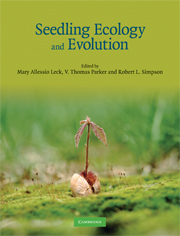Book contents
- Frontmatter
- Contents
- Contributors
- Foreword by Peter J. Grubb
- Preface
- Acknowledgments
- Part I Introduction
- Part II Seedling diversity
- Part III Seedling morphology, evolution, and physiology
- Part IV Life history implications
- Chapter 10 The seedling as part of a plant's life history strategy
- Chapter 11 Seedling recruitment and population ecology
- Chapter 12 Seedling communities
- Chapter 13 Spatial variation in seedling emergence and establishment – functional groups among and within habitats?
- Part V Applications
- Part VI Synthesis
- References
- Index
Chapter 10 - The seedling as part of a plant's life history strategy
Published online by Cambridge University Press: 05 June 2012
- Frontmatter
- Contents
- Contributors
- Foreword by Peter J. Grubb
- Preface
- Acknowledgments
- Part I Introduction
- Part II Seedling diversity
- Part III Seedling morphology, evolution, and physiology
- Part IV Life history implications
- Chapter 10 The seedling as part of a plant's life history strategy
- Chapter 11 Seedling recruitment and population ecology
- Chapter 12 Seedling communities
- Chapter 13 Spatial variation in seedling emergence and establishment – functional groups among and within habitats?
- Part V Applications
- Part VI Synthesis
- References
- Index
Summary
Introduction
In this chapter, we will describe the intricate links between seedling ecology and life history traits such as seed mass, time to maturity, adult size, and reproductive life span. We will pay particular attention to seed mass, as this is the trait most closely linked to seedling ecology. Seed mass affects the initial size of the seedlings, the amount of reserves seedlings have for establishment, the sites to which seeds are dispersed, and the time seeds spend in the soil before germinating.
Much of our understanding of seed and seedling ecology has been based on the idea that plants face a trade-off between producing a few large seeds, each with high rates of survival as seedlings, versus producing many small seeds, each with lower rates of survival as seedlings. We, therefore, begin by reviewing the evidence for this trade-off. Our review shows that a full understanding of seed and seedling ecology requires consideration of life history variables such as plant height, reproductive life span, and the length of the juvenile period. Then we present a new framework for understanding seed and seedling traits as part of an overall life history strategy. Next we outline relationships between seed and seedling traits and other aspects of plant ecological strategy, such as seed dispersal syndrome, the capability to form soil seed banks, tissue density, and adult plant traits.
- Type
- Chapter
- Information
- Seedling Ecology and Evolution , pp. 217 - 238Publisher: Cambridge University PressPrint publication year: 2008
- 58
- Cited by



